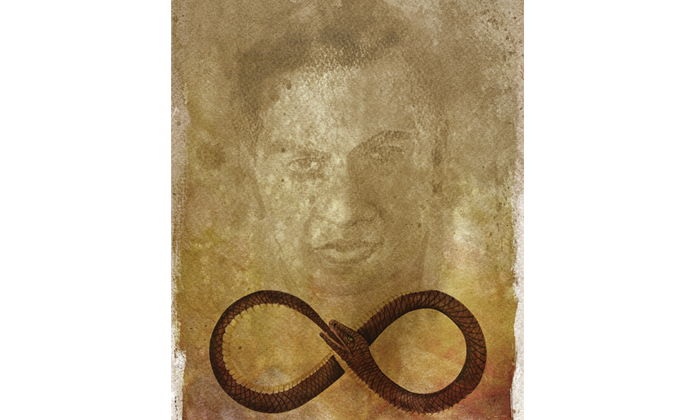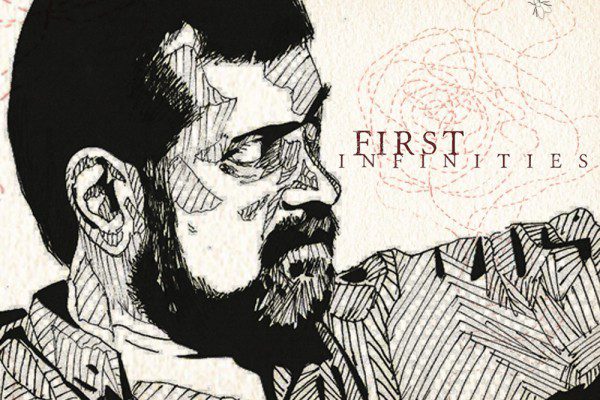The facts of Victor Jara’s tragic death are well-documented. Arrested in the aftermath of a military coup d’etat, Jara was one of many political prisoners led to the National Football Stadium where many were tortured, beaten and executed. Although his hands were broken or, as many have claimed, amputated, Jara continued to sing a song supporting the ousted Popular Unity Party. After receiving many brutal blows, Jara stopped singing only when a machine gun fired by a military officer took his life. In the nearly three decades since, Jara’s songs and spirit have been celebrated by numerous politically-minded folksingers including Pete Seeger and Tom Paxton. Arlo Guthrie set Adrian Mitchell’s ballad, “Victor Jara,” and recorded it on his album, Amigo. Undoubtedly, although Jara’s heart may have been forcefully stilled, his music has lived on.
Thakte balad na kore chash/tar dukho baromash (He that owns the ox but won’t till the land/his sorrow shall be everlasting)…Khana’s vachana
Mathematically, how would you fix Jara’s IQ level? Is it his fortitude? Is it his proficiency with music? Is it the past academic marksheet? Under what of parameters can you quantify courage?
Let me get into the heart of another example. This time, about framing of images within images. How do you frame the image of an image? What is the mathematical permutation of framing recollection? How do you quantify necessary nostalgia with the not so necessary ones?
There is an oft-repeated Kolkata story of the legendary Jyotish Chakraborty of the Bhonwanipore based studio called Image Photographers. During Cartier Bresson’s 1986 visit to Kolkata (to shoot the reactions of people while watching the solar eclipse), well-known actor Basanta Chowdhury took Jyotishbabu to the house of Neotias for a meeting with the legend. Bresson and Jyotishbabu got talking, when the latter requested the maestro to pose for a photograph.
The famously reclusive Bresson, pondered for a while and then agreed to pose for one shot (with explicit instructions that the photograph could only be published after his death).
The spot which Bresson chose to stand had a very low light and posed a photographic challenge but Jyotishbabu rose to the occasion. What came out, according to Bresson, was a portrait that he felt represented him best.
Each time I look at the photograph, I am reminded of that constant tussle between the image maker and the image creator. The maker wants to create his own roadblocks, increase his own sepia tone, add his own shades of grey and the creator who is trying to catch the making of the maker, plays his own cat and mouse game to frame the moment. What comes out is neither an image nor a treatment but an essay, on the grey area between the essential shadow and the non-essential shadow. Which brings me to the next question: how do you fix a constant for the grey area?
The shadow of Bresson, the sub-text of Bresson is framed to near-perfection by Jyotish Chakraborty ( his corpus needs a much needed revisit). What would be that exact number which encompasses the overlapping zone that lie between those shadows? Capturing the implicit and the can-be-seen explicit result?
Be it Victor Jara or Jyotish Chakraborty or any such creatures of fortitude and imagination, it is difficult to quantify the infinity that lies within them. For that matter, any of us.
And the man who came closest to framing that infinity in terms of mathematics would be the home-grown maverick maestro Srinivasa Ramanujan.
It is so easy to paint Ramanujan as a tragic hero, complete with the story of untimely death. It is easy to call him a genius. Even easier to rattle off his mathematical achievements and forget the core of his being. What is difficult to admit is how our system, then and now, is pathetically under-equipped to understand the making of a Ramanujan.
For the record, Ramanujan had to face a mainstream academic rejection from Government Arts College-Kumbakonam and Pachaiyappa Arts College-Chennai for failing the examination and ultimately had to pursue his own mathematical direction. Here is a story of one of the foremost mathematicians of the world, who, till his death, did not have a valid Indian degree.
Which brings us to the next question. How do you quantify and qualify the study of mathematics in this sub-continent, which is all about recall? Which is all about how you remember the formulae or the derivate. Not about how to look at detours even if the entire formulae is given. As a result, we have created our own phobia and institutionalised the so-called classification of arts-type, science-type, commerce-type, career-type, creative-type, dropout-type, fringe-type… and the list of the “type” is longer than the bandwidth of our imagination.
Isn’t a music composer, in a different way, looking at mathematics? Isn’t a theatre director and his relationship with space revealing a sense of mathematical metaphor? In this basic question lies Ramanujan. His endless search that morphs into detours like that famous remark: An equation for me has no meaning, unless it represents a thought of God.
And no, it isn’t the Indian romantic in me. (Though I firmly believe that mathematics without romanticism is just number slavery…and there are no bigger romantics than Bhaskara, Baudhyana, Alan Turing, Georg Buchner, Lewis Carroll, Muhammad ibn Musa al-Khwarizmi…) It is the liberal rationalist in me that would believe in Ramanujan’s strength from the Goddess Namagiri, from Namakkal which is another way of looking at the rationale of faith – the faith which is not a fanaticism of rituals or accumulation of divine brownie points. That is why Kabir is an important Marxist of our times and Stalin is an innovative fascist belonging to the same universe. That is why Salbega is a socialist and romanticism apart, purely in term of sustainability (of a revolution), a Long March cannot (and will not be) as effective as Dandi march. That god-touch (borrowing from Sri Aurobindo) impulse(not to be confused with religious adherence) is what made Einstein realise the importance of Gandhi or propelled Chandralekha to create her magical dance tribute to a sense of mathematics called Yantra.
Let us look into the word equation. The word always conveys a sense of balance. And it is this balance and sense of equality (or shall we say equilibrium) that we seek all the time. Some people would tamely call it status quo, but others would call it a sense of sculpting the notion of equality. Within this word, there is so much mathematics, yet so much life. So much physics, chemistry, economics and at the same time so much everything else. What would be the equation of freedom? How would you equate guilt? What is the equation for equivocation? Can a mathematical state of zero be equated with a spiritual sense of shunya or the idea of blank verse? One man’s equation can be another man’s compromise. One man’s equation can be the other man’s notion of azaadi or gumshuda (depending on the historical and the here-and-now social context).
This nether zone of playing with numbers. Decoding numbers. Not always to prove but to always seek the proof is what characterises Ramanujan. And that is what pushes the envelope. That is what opens up new frontiers. The musician who is grappling with notes and anti-notes, the voice coach looking at nodes and anti-nodes, the poet who is challenging the meter and the baul who plays the gab-gubi have enough reasons to thank Ramanujan.
As a nation, as a democracy, as a nerve centre for various faiths, as a laboratory of hope and despair, as a sense of majority or minority, as the notion of accuracy in an opinion poll, as a yardstick – even in something as banal a phenomenon as housefull in a cinema, we are constantly grappling with the numerical idea of pre-requisite. We either exceed or lack in numbers. We are either inundated or woefully fall short.
What is the equation of that expectation? Can there be a universally optimum digit? Can we manufacture that all encompassing number? One never knows. Probably, one can never know. Probably, one should never know. Probably, we will have to live with a world called: quorum. Or that constant nagging question that shall continue to haunt humanity – how much is enough?
I do not think declaring December 22 as the National Mathematics Day will change anything. Because the spirit of Ramanujan has been molested; the spirit which makes equations leap. Remember you have to kill— or create circumstances that shall lead to death, near death and decimation— a Copernicus, Socrates, Galileo, Giordano Bruno or a Subhash Mukherjee (pioneer of test tube baby) because they did not just discover, they were pushing frontiers of existing knowledge, faith, axioms of truth, all at the same time. They were walking the grey area between truth and lie, unconcerned about binaries. They were looking at the convenience, inconvenience, tactical, polemical, political and spiritual nature of truth and thus challenging the lie or proving it otherwise.
So, like Gandhi, Ambedkar, Jayprakash Narayan, Periyar, like the brilliant Hamid Dalwai… assassinate the idea of dissent in Ramanujan by mounting more seminars rather than seeking to broaden the area of mathematics ( or even teaching the history of the subject) in the humdrum of a repressive syllabus-driven system.
Tomorrow will be an almost-dead sunrise. There will be fresh dead-ends. Some rational voice will cry out from that bleakness saying: let’s stitch syllables… let’s weave water… let’s probe numbers… let’s constantly re-examine but not reject the idea and sense of faith… let’s understand the matrix of harmony. That feeble voice from Kumbakonam (now more known for degree coffee) will be one Srinivasa Ramanujan.
Why don’t you take off your noise cancellation headphone and hear him out? But then, you won’t. What you would rather do is what was done to the rational seeker Khana who existed between 9th and 12th century in medieval Bengal.
We merely cut her tongue.
Let’s do that to Ramanujan. Then order a bouquet for his 125th birth commemoration.














